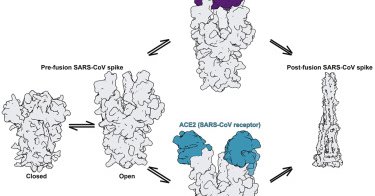
The Veesler Lab
@veeslerlab
Followers
6K
Following
1K
Media
343
Statuses
1K
Pathogen entry into cells, host immune responses & vaccine design: structural biology, protein design, virology & immunology @HHMINEWS @UWBiochemistry
Seattle, WA
Joined October 2014
Delighted to share the peer-reviewed version of our article describing a prefusion-stabilized MARV GP vaccine immunogen and a best-in-class MARV neutralizing and protective antibody! Led by Amin Addetia with @VirBiotech
@HHMINEWS
https://t.co/SI78iXWkef
nature.com
Nature - Potent neutralization of Marburg virus by a vaccine-elicited antibody
0
5
10
Today in @ScienceMagazine, we report a new DNA editing technology to seamlessly write massive changes into the right place in the human genome. The reason gene editing hasn't transformed human health is that current gene editing technologies like CRISPR are very limited. The
What if we could universally recombine, insert, delete, or invert any two pieces of DNA? In back-to-back @Nature papers, we report the discovery of bridge RNAs and 3 atomic structures of the first natural RNA-guided recombinase - a new mechanism for programmable genome design
74
676
3K
Incredibly honoured to be taking up an exciting new chair of Global Health here at Cambridge and co-directorship of the Hong Kong Jockey Club Global Health Institute based out of Hong Kong in partnership with HKU and International Vaccine Institute (IVI). @HKU_SPH @Cambridge_Uni
11
9
39
@bblarsen1 @CaelanRadford @VUMC_Vaccines @veeslerlab The final version of our pseudovirus deep mutational scanning of the Nipah virus receptor-binding protein is now published. https://t.co/j27UvS6NpJ
0
4
11
Delighted to see @arcinstitute research highlighted by Vox's Future Perfect 50 list!
Excited that our Core investigators and Cofounders @SKonermann and @pdhsu are on this year's @voxdotcom #FuturePerfect50 List, highlighting also the work of @li_lingyin, Songnan Wang, @mgdurrant, and @ntperry13. https://t.co/WGp0dZrqdh
7
5
91
We found that even an antibody targeting the S N-terminal domain (S2L20) and preventing the receptor-binding domain from closing promotes S ratcheting and fusogenic triggering! 5/6
1
6
13
In this manuscript, we dissect what makes a functional receptor from a mechanistic standpoint and shows that two key features to promote entry into cells are proper spatial/geometric organization & the ability to induce this ratcheting mechanism 4/5
1
7
13
This movie made with @janetiwasa summarizes this ratcheting mechanism 3/5 https://t.co/f5JFjESjbi
1
14
38
In 2019, we proposed w @coronalexington @axiong_x that coronavirus entry into cells involves a spike (S) molecular ratcheting mechanism & discovered that antibodies could functionally mimic the receptor by inducing these S conformational changes 2/5 https://t.co/wHTN4qkNzN
cell.com
Structural analysis of the SARS-CoV S and MERS-CoV S glycoproteins in complex with neutralizing antibodies from human survivors sheds light into the mechanisms of membrane fusion and neutralization
1
4
16
Excited to share our latest work elucidating the mechanisms of coronavirus entry into cells! Led by @Dr_MattMcCallum on our side in collaboration with Huan Yan's lab (TaiKang Center for Life and Medical Sciences) https://t.co/YN9XyQvS4o 1/5
nature.com
Nature - A strategy using engineered functional customized viral receptors enables the development of functional infection models for coronaviruses whose native cellular receptors are unknown.
3
36
116
Collectively, these data indicate that receptor interference is a primary mechanism of PDCoV neutralization, inform immunity against deltacoronaviruses and will guide the design of vaccines for swine & human populations 6/7
1
2
5
PD33 and PD41 escape profiles do not overlap, with the exception of substitutions to site G319, which are universally deleterious for receptor-binding affinity, and these 2 mAbs could thus be used as a cocktail with enhanced resistance to escape 5/7
1
1
3
For the 2 most potent mAbs (PD33 and PD41), most escape mutations led to dampening of gAPN-binding avidity, suggesting that they would not be tolerated due to reduced viral fitness 4/7
1
1
3
During the review process, we added deep-mutational scanning data from @tylernstarr lab to identify mutations that escape binding of four neutralizing mAbs (PD17, PD20, PD33, and PD41) and two non-neutralizing mAbs (PD3 and PD8) 3/7
1
1
4
The initial thread describing our @biorxivpreprint can be found here 2/7 https://t.co/kI0PQdY45g
PDCoV was shown to be able to use human APN for cell entry and was recently associated with multiple zoonotic transmission events in children with acute undifferentiated febrile illness https://t.co/5JxKAyNUMU
https://t.co/57rWA4dseG 2/15
1
1
3
The peer-reviewed version of our study describing monoclonal antibodies (mAbs) inhibiting porcine deltacoronavirus, which jumped to humans multiple times recently, is now online 1/7 https://t.co/YwyjQatkij
1
11
32
@Dr_MattMcCallum is on the faculty job market. Catch him if you can! He is incredibly talented & innovative! 9/9
0
2
11
We show that the stabilization strategy we designed is broadly applicable to alpha-, beta-, and gamma-Herpesviruses, pointing to a shared fusion mechanism and paving the way to develop vaccines against these pathogens 8/9
1
2
4






